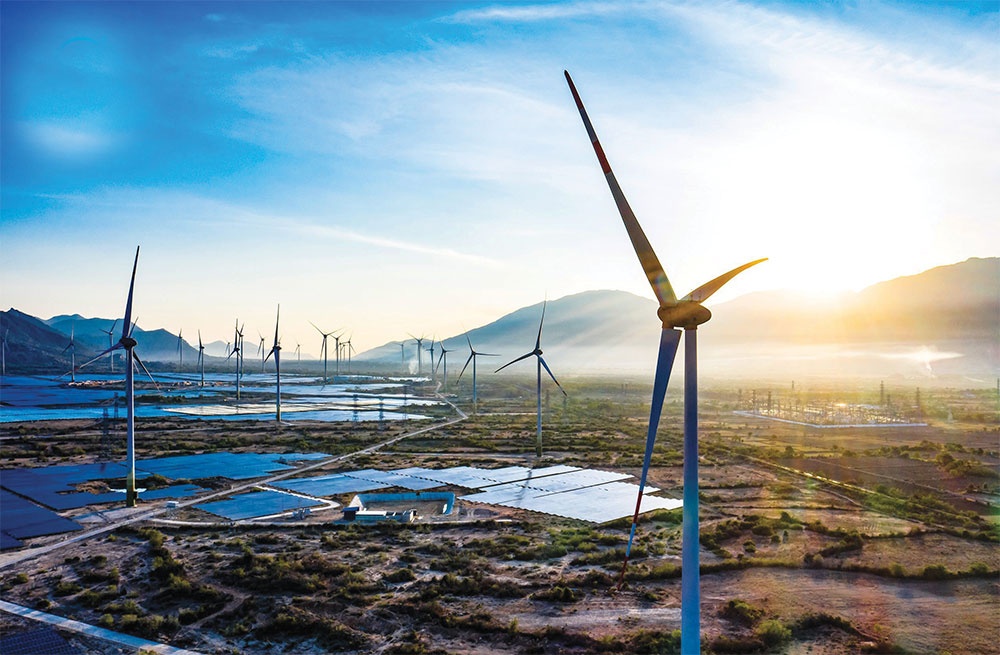Powering Vietnam’s green growth with new power plan
From a developmental standpoint, the Power Development Plan VIII (PDP8) reads as a comprehensive framework aimed at fostering an independent and self-reliant economy, enhancing the wellbeing of the population, and ensuring national defence and security.
 |
| Philipp Munzinger, director of the German Development’s Agency’s Energy Support Programme |
The plan sets a high bar for the upcoming energy transition phases by prioritising national energy security at the most affordable cost, which is a rational prerequisite to guaranteeing universally accessible energy that supports equitable and inclusive growth. With an anticipated annual GDP growth rate of 7 per cent until 2030, the PDP8 projects a power demand factor of 1.3, representing a higher proportion than in recent years.
Vietnam has witnessed a remarkable surge in solar and wind power capacity growth between 2019 and 2021, positioning itself as a frontrunner for clean energy adoption among Southeast Asian nations. Solar (21 per cent) and wind (5 per cent) power, alongside hydropower (30 per cent), collectively constitute over half of the country’s installed energy capacity. However, the lack of grid development has hindered the full utilisation of its generation potential thus far.
To enable the seamless integration of the currently installed and upcoming volatile green power sources, there is a pressing need to significantly expand transmission lines and enhance grid flexibility in the coming years. Addressing this challenge, the PDP8 envisions an investment of $15 billion in transmission line infrastructure by 2030.
The PDP8 recognises the Just Energy Transition Partnership (JETP) as a crucial mechanism for enhancing the ambition levels of the 2030 targets to accelerate the country’s energy transition. While the final PDP8 aligns the JETP coal capacity peak target in 2030, the focus lies on increasing the share of renewable energy in the power mix and reducing peak coal sector emissions.
The JETP has set forth ambitious goals of 47 per cent renewable energy share and a reduction to 170 metric tonnes of CO2 peak emissions in the coal sector in 2030. The effectiveness of international support, in the form of public concessional loans, private investments, and technical assistance, will heavily rely on the capacity of international partners to deliver, as well as the government’s willingness and ability to effectively utilise and implement the respective commitments beyond the PDP8.
Attractive source of energy
The plan establishes targets for renewable energy expansion, including a substantial increase in onshore wind capacity from 4.5GW to over 21GW by 2030. This signifies a much-needed boost in response to current market stagnation caused by expired feed-in tariffs and grid overload, leading to curtailments. Market-based auctions combined with optimised licence granting procedures are expected to stimulate further growth in wind power over the next years.
In the offshore wind sector, the PDP8 calls for a capacity of 6GW by 2030. To facilitate this, preparations are underway to complete the marine spatial plan and other regulatory groundwork required for Southeast Asia’s first offshore wind farms. Swiftly establishing this framework is crucial, considering the extensive lead times associated with offshore wind projects. Vietnam boasts a coastline stretching over 3,200 km, making it ASEAN’s most promising location for offshore wind power generation.
The PDP8 envisions a total capacity of 70-91GW by 2050, highlighting the immense potential Vietnam possesses. Offshore wind is seen as an attractive source for producing green hydrogen and ammonia, which can be used to decarbonise nearby industries. Recognising this potential, the PDP8 outlines substantial additional capacities, targeting 15GW by 2035 and an impressive 240GW by 2050.
While larger utility-scale solar capacity expansion plans are not immediate, the PDP8 outlines ambitious targets for rooftop solar (RTS) installations. By 2030, the plan aims to implement RTS self-consumption systems in half of public office buildings and half of residential households.
Additionally, the PDP8 eliminates the 1MW capacity limit for industrial RTS, allowing for larger system sizes. Prioritising the growth of decentralised RTS plants is a sensible strategy in the PDP8, as it can potentially augment solar power capacity in northern Vietnam without straining the grid. This is especially important during the hot season, when hydropower resources deplete and electricity demand rises due to increased cooling needs. It can also significantly reduce power outages and contribute to addressing these challenges.
Shifting away from the current “zero export” approach in policy could enable RTS power producers to inject surplus solar electricity into the grid with minimal compensation, thereby fostering greater related investment. This approach could commence in areas where the grid is capable of accommodating and balancing decentralised solar power resources.
 |
| The power sector must replace coal and gas with solar and wind to supply electricity alongside the nation’s economic growth ambitions, photo Le Toan |
Expansion of value chains
In terms of battery storage, the plan sets a target of achieving 0.3GW by 2030, followed by a substantial expansion to approx. 30.6-45.5GW in the following two decades. The importance of battery storage cannot be overstated when it comes to ensuring the flexibility of our future power system, particularly since the capacity of pumped water storage is limited.
Even at present, smaller-scale battery storage solutions can play a crucial role in enhancing distributed power generation and relieving strain on the grid. For example, rooftop solar can be utilised to charge the growing number of electric vehicles, a practice that is gaining momentum in markets such as India and Australia.
The expansion of local value chains in energy transition technologies offers a promising opportunity for Vietnam’s flourishing production industries. In pursuit of this, the PDP8 outlines the establishment of two inter-regional centres to manufacture renewable energy equipment and provide related services. Furthermore, there is a consideration to develop renewable energy industry ecosystems in all regions. This strategic approach is vital as Vietnam strives to meet evolving international green production standards and remain competitive.
In terms of coal, the PDP8 sets a target to reach 30.127GW peak coal power capacity in 2030. To achieve this, the plan identifies specific plants that will be completed and deployed, while also highlighting those that will not be pursued. Beyond 2030, the focus shifts to fuel conversions, considering options such as biomass or green ammonia, to decarbonise the remaining coal fleet.
Establishing early engagement with the coal industry is crucial to explore technically, economically, and socially viable pathways for this transition. The global project on innovative regions for a just energy transition, funded by the European Union and Germany, is assisting eight countries, including Vietnam, in transitioning from coal-based economies to sustainable alternatives through knowledge exchange, technical advice, and stakeholder engagement.
In order to achieve a carbon-neutral economy, the power sector is facing a dual challenge. Not only it is pressured to replace coal and gas with solar and wind to supply typical electricity consumers at a 7 per cent GDP growth rate.
Especially for 2030-2050, renewable energy capacities are needed to decarbonise the transport sector through green electrification and produce green hydrogen and ammonia, first and foremost for high-emitting industries like steel and chemicals. Direct green power has limited impact in these industries, necessitating alternative energy carriers.
Lastly, energy efficiency enhancement will be a vital factor in driving Vietnam’s green growth. It is essential to complement power system efficiency measures with demand-side interventions to align economic growth with energy intensity goals. By setting measurable efficiency targets in different sectors, in line with the saving measures outlined in the PDP8, the transition to a clean energy-based economy can be facilitated substantially.
 | Power overhaul plan picks up steam The newly approved Power Development Plan for this decade heads up a charge to adhere to Vietnam’s strong commitments to net-zero, but there is still an enormous amount of work to be done. |
 | Power plan a leap in the right direction for 2050 ambitions Vietnam’s Power Development Plan VIII (PDP8) will enable the power sector to align with the nation’s international commitments, including the Just Energy Transition Partnership. It is the dawn of green and sustainable development for the sector, with the hope of restarting pending power projects and contributing to net-zero commitments by 2050. |
What the stars mean:
★ Poor ★ ★ Promising ★★★ Good ★★★★ Very good ★★★★★ Exceptional
Related Contents
Latest News
More News
- Heavy industries set for pilot greenhouse gas quotas (December 25, 2025 | 10:00)
- Swedfund invests in MSME growth and climate action in Vietnam (December 19, 2025 | 11:42)
- GreenYellow brings solar energy to light up remote schools in Tuyen Quang province (December 19, 2025 | 08:00)
- Charge+, Grab partner to develop EV charging network in Vietnam (December 18, 2025 | 17:11)
- Linking sci-tech and innovation to Vietnam’s net-zero future (December 18, 2025 | 14:31)
- Driving double-digit growth through green and circular transformation in Vietnam (December 17, 2025 | 09:00)
- Standard Chartered and ACCA deepen collaboration to develop Vietnam’s talent for a sustainable future (December 15, 2025 | 18:18)
- Schaeffler reports strong early output from Dong Nai solar project (December 12, 2025 | 15:16)
- Forestry conference highlights biodiversity and sustainability goals (December 09, 2025 | 13:35)
- Home Credit honoured among top 10 sustainable companies in trade and services (December 09, 2025 | 12:18)

 Tag:
Tag:



















 Mobile Version
Mobile Version